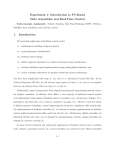Download Laboratory Exercise 4 - Servo Motor
Transcript
Laboratory Exercise 4 - Servo Motor Objectives: 1. Understand the servo motor driver circuit 2. Familiarized with the servo motor characteristics Theory Servo motors are used in many applications because they provide a reliable and controlled movement. A servo motor consists of a DC motor a small electronic feedback system which includes a potentiometer and a gear system. A typical servo motor consists of three wires. A power and a ground wires and a signal wire. The signal wire is used to provide the motor the necessary pulse to drive it. Servo motors are really simple to drive but they can be delicate too. You must be careful when driving a servo motor since a high frequency pulse can permanently damage the motor. Always review the motor datasheet before running it. Since the only requirement to drive a servo motor is to provide the signal wire with the correct pulse, we will be discussing how to achieve the correct pulse to drive these motors. Usually a servo motor requires a low frequency (about 50 Hz) and a low duty cycle range to operate (0.9 to 2.1 ms). In order to achieve the required range of operation the driver board uses as 555 timer and a potentiometer to adjust the duty cycle. The frequency of the timer is already fixed to about 50 Hz. Materials & Procedure For this experiment you will need: • • • • • • Servo Motor Power Supply Wires Multimeter Oscilloscope (Utility Board can be used) External PIC or microcontroller Driving a servo motor is very simple but you must be careful when implementing the circuit. Always verify the circuit with an oscilloscope before connecting the motor. 1. Power the Driver Board using its adaptor. Make sure the PWR switch is in the OFF position. 2. Locate the PIC/MAN switch on the controller side of the servo motor. Select the manual (MAN) mode. 3. Based on your motor, connect the right power rating to the SRV PWR terminals 4. Connect the wires of the motor to the SRV‐OUT terminals or use the servo motor pins if your motor has the right connector. 5. Turn the Driver Board ON using the PWR switch on the POWER module. 6. Use the Start/Stop selector switch to start the motor. If the switch is in the Start position the motor will start as soon as the leads of the motor (and power) are connected. 7. Use the potentiometer to move motor. Questions • • Observe the timer pulses and explain how this affects the performance of the motor. Use the oscilloscope to see the duty cycle and comment on your findings. Explain the basic characteristics of the motor such as speed and torque when there is no load. Increment the load on the motor and verify the speed and torque characteristics. Compare and comment on the no load versus load performance. Similarly to the previous exercises, we will be using the Microcontroller Board as an external PIC to provide the required signal to drive the servo motor. All it is required to drive the servo motor is to provide a low signal and low duty cycle range to the driver board input on the servo module. The GND terminal must ALWAYS be connect to the ground terminal of the external microcontroller. To use the external microcontroller the PIC/MAN selector switch must be placed on the PIC mode. 1. Follow the instructions on the Microcontroller User Manual or Lab Manual to create a program that provides a low frequency clock signal. Connect the PIC terminals to the Driver Board input terminals (DO NOT forget the ground connection) and run the motor. 2. Vary the duty cycle the clock pulse on the program and comment on the motor characteristics when it is running with and without load.



